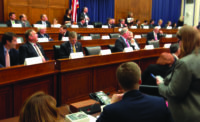The transportation construction industry’s attention is riveted on the Senate as key lawmakers work out details of a long-term highway-transit authorization bill.
Negotiations will go into the weekend, one participant says, and Majority Leader Mitch McConnell (R-Ky.), a central player, has said he plans to have a July 21 vote, probably a procedural one, on the measure.
As construction officials watch the developments, several important questions remain unanswered: How long will the Senate bill be? How much funding will it authorize? What revenue-raisers will it include to offset the expected increased spending over current levels?
Industry executives welcome the activity. Pete Ruane, American Road and Transportation Builders Association president and CEO, says, “The good news is, this is moving forward aggressively.”
Senate negotiators face a tight deadline: The current two-month highway-transit authorization—the latest in a long series of stopgap measures—expires July 31.
The Senate Finance Committee’s top Democrat, Ron Wyden of Oregon, told an ARTBA conference on July 16 that decisions on the chamber’s highway-transit legislation will be made within days.
Wyden, a participant in the talks, said, “This crucial effort to … finally, finally, finally get a long-term transportation bill … is basically going to be coming out of the gate early next week.”
Another key Senate negotiator, Environment and Public Works Committee Chairman James Inhofe (R-Okla.), says, “We’re committed to a six-year bill. We have made huge strides in that direction.”
Speaking to reporters after he addressed the ARTBA conference, Inhofe said, “You can’t do the things that need to be done without a fairly long-term bill—four, five, six years it has to be—in order to have, number one, [funding for] the long-term projects and, number two, the [policy] reforms.”
Ruane said an interview that “part and parcel of this whole Senate proposal” will be the DRIVE Act, a $277-billion, six-year highway measure that the EPW committee approved unanimously on June 25. Inhofe says that legislation would increase highway funding by about 3% a year.
The package also will include transit and highway-safety titles. The commerce committee has approved safety provisions, but some of the language, which affects labor unions, is viewed as a dealbreaker if it stays in the final package.
The length and size of the expected new package will depend on the amount of revenue-raisers negotiators can agree to. Inhofe said Senate Finance Committee leaders have compiled a list of such “pay-fors” that are under discussion.
The House batted the ball into the Senate’s court on July 15, when it approved a further five-month highway-transit extension, which the Congressional Budget Office estimated at $8.1 billion.
The weakening Highway Trust Fund needs that amount of revenue to stay out of a deficit through December.
The House measure’s architects—Ways and Means Committee Chairman Paul Ryan (R-Wis.) and Transportation and Infrastructure Chairman Bill Shuster (R-Pa.)—say their legislation also will provide time for them work on their version of a multiyear highway-transit bill in the fall.
Transportation Secretary Anthony Foxx told ENR in a brief interview on July 16 that “the House moving is a big step—[it] creates certainty on that end of the Capitol.” The White House issued a statement supporting the House bill.
If the Senate can pass a multiyear bill, that, of course, wouldn’t be the final step.
Ruane says, “Obviously there’s going to be a critical moment in the next two weeks where the House has got to decide whether they’re going to fight the Senate and try to push their version through or they’re going to come to terms on some kind of, hopefully short-term, extension and come back in the fall and put [the long-range measure] to bed.”


